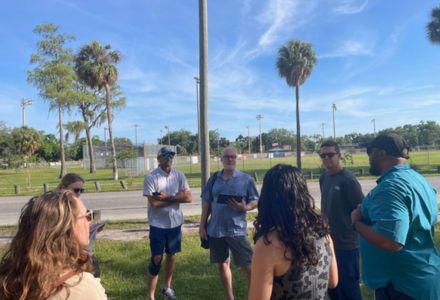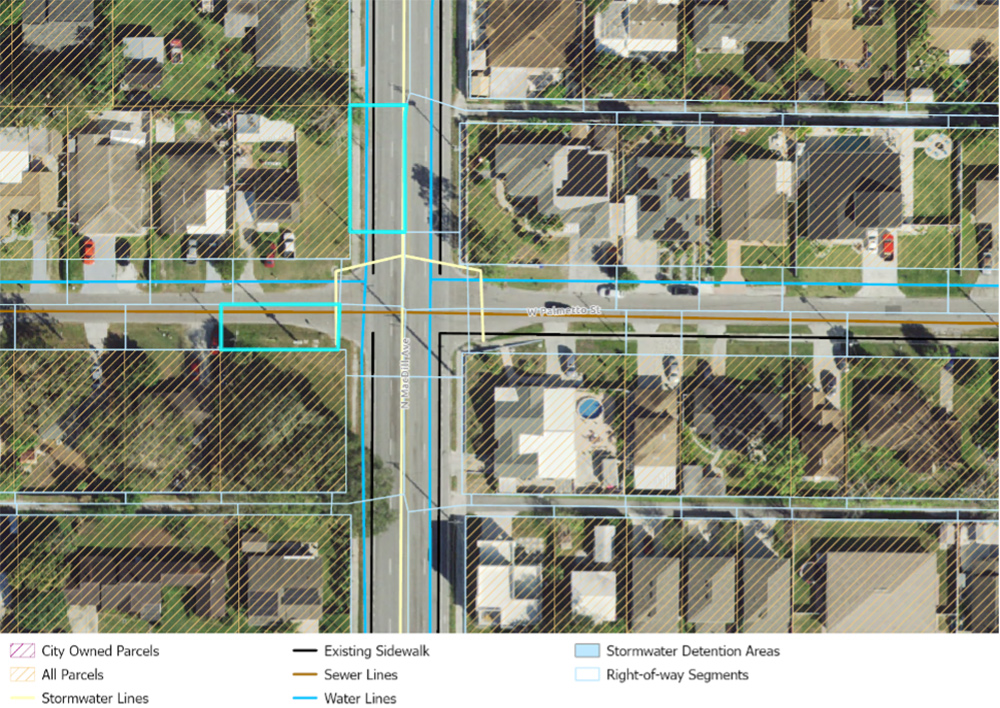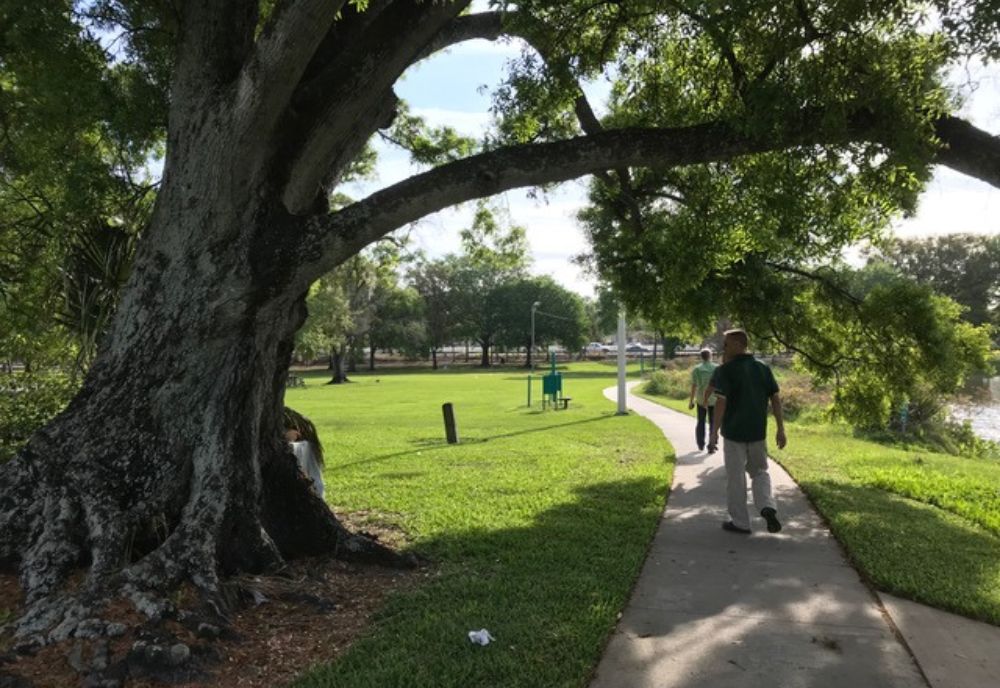The City of Tampa revised its tree protection ordinance beginning in 2006 requiring a tree canopy study every five years. A tree canopy is a measurement that encompasses the layer of leaves, branches and stems of trees that shelter the ground when viewed from above, providing much-needed shade, stormwater management, reduced air pollution, and wildlife habitat.

The team engaged with City of Tampa staff to share residents’ concerns related to potential tree canopy locations. (Photo courtesy of Rebecca Zarger)
Dr. Shawn Landry, a research associate professor in the School of Geosciences and director of the USF Water Institute, and Dr. Rebecca Zarger, an associate professor in the Department of Anthropology, are two USF College of Arts and Sciences faculty contributing to the City of Tampa’s study. As co-primary investigators on the study, Landry and Zarger are tasked with identifying specific tree planting locations throughout the city and conducting outreach with residents in priority locations.
“In response to the 2021 study which showed a decline in tree canopy since 2011, the mayor initiated a campaign to plant 30,000 trees by 2030. In addition to other programs, they recently received a $1 million USDA grant to plant trees,” Landry said. “They reached out to us to assist them in locating specific potential tree planting locations and to work with residents to discuss their preferences and concerns and identify desirable planting locations.”
Over two years, Zarger and anthropology doctoral student Kira Rib conducted social science research on resident experiences of Tampa’s urban forest, including a survey and interviews focused on values, priorities, and social equity related to trees for people living in Tampa.
“Our research team presented to the Tampa City Council twice over the last year and held a public workshop with city staff in July 2023 on report findings. The findings have both raised awareness and prompted action from policy and decision-makers as well as residents,” Zarger said.
Some of the main concerns from residents included the public wanting to see more trees planted, despite the high cost of maintenance, the overall concern about tree canopy loss due to development, and the fairness and equity of tree canopies.
The city’s USDA grant is specifically dedicated to assessing the need for urban tree canopies in “disadvantaged communities” as defined by the White House Justice 40 Initiative.
“Our 2021 study showed that areas of the city were substantially hotter in areas with lower amounts of tree canopy and other vegetation. We also showed that lower-income areas were substantially hotter than higher-income areas,” Landry said. “This project aims to address this inequity by planting trees in lower-income areas of the city that are hotter and have lower canopy cover.”
“Understanding community members’ priorities and concerns and charting a path for collaboration from the beginning is critical to the success of urban tree planting efforts,” Zarger explained. “Residents want to know how they might contribute to efforts to green the city but also have concerns about where trees will be planted and who will maintain them in the future.”
According to Landry, the majority of tree canopy in the city is located on or adjacent to residential land, so he notes that community members must be involved, as any tree planted in the right-of-way could affect the home adjacent to that tree.
“The city will not be successful with the goal of planting 30,000 trees by 2030 unless they work with residents to find desirable planting locations throughout residential neighborhoods,” Landry said.
Beyond the resident outreach and interviews, there is the task of physically mapping the potential locations for new trees. For this, the team uses a geographic information system (GIS), which is a computer system that analyzes and displays geographically referenced information.

GIS mapping helps to identify potential tree planting locations, taking into consideration parcel type, infrastructure, and right-of-way. (Image courtesy of Shawn Landry)
“The GIS system is used as a screening tool to identify ‘potential planting locations’ by tagging each right-of-way segment or parcel with attributes that indicate potential conflicts with pipes, overhead lines and other conflicts, as well as the availability of planting space sufficient for a tree to grow,” Landry explained. “Essentially, the GIS screening tool helps to identify the specific locations where trees ‘might’ be planted, and then the community, along with city foresters and landscape planners, can help decide where trees ‘should’ be planted.”
Landry added that “planting trees is actually quite difficult,” and reflected on a 1946 quote by Charles A. Young, a forester in the City of Baltimore: “I was under the impression that all people like to have trees planted in front of their houses, until I started planting trees in front of houses.”
The team hopes that by using technology and working with neighborhood residents they aim to develop an efficient and repeatable process that the city can use to meet the goal of planting 30,000 trees, while also addressing the city’s Comprehensive Plan and Resilient Tampa plans to ensure equitable tree mitigation and planting.
“We hope that this tree planting effort serves as a step in the right direction to address residents’ concerns and priorities that they have shared with us over the last couple of years,” Zarger said. “One thing we can say without a doubt is that people in Tampa have strong feelings about trees. Whether that is to protect the trees we have, plant new ones; or care for them in the face of weather hazards, or remove them because of the need for new buildings. What happens with trees in the future of our city is up to all of us.”
